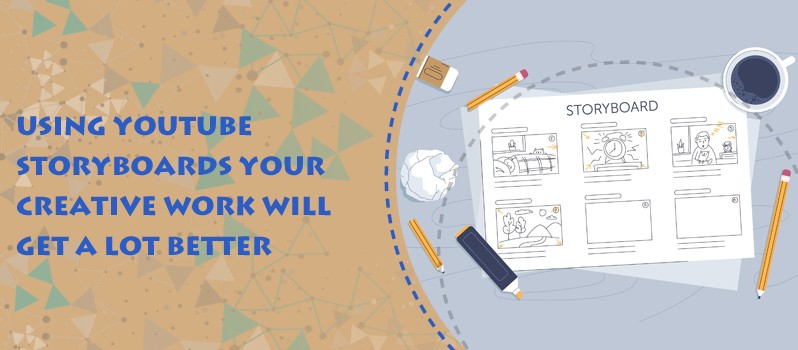Using YouTube Storyboards Your Creative Work Will Get A Lot Better
Storyboarding is a process of visually creating a “comic strip” of a narrative, usually with images and dialogue. Storyboards make it easy to see every scene in your story, as well as adding visual details that can help you out when writing the script. If you are looking for more information on how to use YouTube Storyboard, we’ve got a blog post on here with tips and tricks!
What is a Storyboard?
Storyboards are a visual way to plan out your creative work. When you create a YouTube storyboard, you outline each scene in your video beforehand and then plot out how the scenes connect to create an overall narrative. This makes creating videos a lot easier because you know exactly what needs to happen in each scene and you can avoid wasting time and money on footage that won’t end up being used. If you’re new to storyboarding, here’s a quick primer on how it works:
1. Choose a visual style for your video. Whether you want to go with a traditional animation look or something more contemporary, having a visual style will help you stay organized while filming.
2. Decide on the scene layout. Storyboards typically have three panels: the top left panel usually contains the setting or background of the scene, the middle panel shows the main characters in action, and the bottom right panel depicts what happens after the scene has ended.
3. Brainstorming scenes. Once you have your layout figured out, start thinking of ideas for scenes that would fit into it. Try not to get bogged down by details at this point; just come up with general concepts that would work well in your video.
How can storyboards help your creative work?
Storyboards have become an essential part of the creative process for both filmmakers and graphic designers. Used correctly, storyboards can help streamline your creative work, making it easier to communicate your ideas to others and to track progress. Here are four reasons why storyboards can help your creative work:
1. Storyboards can make the process of ideation more streamlined. By breaking down your idea into a series of sequential visuals, you can more easily communicate your thought process to others. This also allows you to track progress more effectively, ensuring that all of your ideas are represented in a clear and easy-to-follow format.
2. They can help to reduce the amount of time needed to complete a project. With storyboards as a guideline, you can quickly and easily create a visual representation of your ideas. This saves you time and money in the long run, since projects that are well organized and well-planned tend to be faster and cheaper to complete than those that are not.
3. They can help you improve upon your creative skills. Storyboarding is a great way to practice your creativity and learn new techniques. By creating storyboards for different types of projects, you can improve upon your skills and possibly find new areas of interest. Over time, you can develop a strong portfolio of work, which is always useful as a professional.
4. They can help you build your reputation and name ID in the industry. To become well-known in an industry, it is necessary to have a particular skill set that allows you to create effective designs. Storyboards allow for easy execution of various types of projects, so it is possible to gain recognition for your abilities and develop a strong portfolio over time.
5. They are a great way to practice drawing skills and exercises. If you want to improve at drawing or any other type of art, storyboarding is definitely a good way to do so! The creative processes involved in creating storyboards help improve skills that can help with other types of art (like taking life drawing classes or studying anatomy). To be honest, I often find that new artists who don’t have exceptional drawing skills suddenly realize as they start creating storyboards.
Why do you think many people choose to learn how to make storyboards? What is it about them that makes them a great tool for learning new skills or honing existing ones? Let me know in the comments below!
Steps for creating a storyboard
Storyboarding is a popular way to communicate and organize your creative work. It can help you to better plan and execute your ideas, and make your work look more professional. Here are five steps for creating a storyboard:
1. Define the overall goal of the project.
2. brainstorm ideas for scenes or sequences that will support the overall goal.
3. create rough sketches of each scene or sequence so that you have a visual idea of what you’re working on.
4. select the best scenes or sequences to build a full storyboard around.
5. add sound effects, music, and other graphic elements to complete the storyboard.
Tips and tricks to make your storyboards more effective
If you’re like most creatives, you probably have some pretty cool ideas for videos that you want to make, but you don’t know how to get started. Well fear not! In this blog post, we’re going to teach you a few tips and tricks to help make your storyboards more effective and help you turn your great ideas into great videos.
One of the first things you’ll want to do is figure out what type of video you want to make. Are you looking to create a short educational video? A promotional video for your business? A funny clip? Whatever the case may be, it’s important that you break down the content of your video so that it can be created in a more organized fashion.
When creating a video, it’s important to think about what will be in the frame and what won’t. This means that if you’re planning on including background music or footage from other videos in your storyboard, make sure to account for those elements in your planning stages. Also, think about how long each scene should be and plan accordingly.
Once you have a rough outline for your video, it’s time to start putting together those storyboards! A storyboard is simply a visual representation of your video. It’s not an actual script, but it does include essential elements of your story-line. You can create a fully fleshed out storyboard that shows each scene of the video, but if you’re working with a smaller budget, or simply don’t have time to do so, you can still take some helpful notes to help guide you through the process. Your storyboard should also include any footage from other videos as well as any music that will be playing during your video. The images and thumbnails for these clips should then be placed in order on your storyboard.The next step is to create a timeline for your video. A timeline is simply a visual representation of where things are going in time and space.




